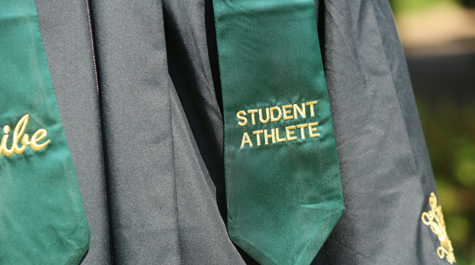W&M Athletics continues to lead way in nation's classrooms
The William & Mary Athletics Department once again led the way in the latest graduation rate data published by the NCAA on Wednesday.
The NCAA report includes both the Federal Graduation Rate (FGR) and the Graduation Success Rate (GSR), two of the three major academic progress reports published by the national office. There were 351 Division I colleges and universities included in the GSR and 344 in the FGR, which measured the cohort of students that entered college in the fall of 2011 and finished by the summer of 2018.
Overall, W&M had 12 of 18 programs measured hold steady or increase in the FGR, and 17 of 19 hold steady or increase in the GSR compared to last year's report.
For the 14th year in a row, William & Mary student-athletes achieved the highest FGR among all public colleges and universities at 88 percent, a full seven points ahead of the next-closest school, the University of Michigan. W&M's student-athlete FGR of 88 percent, and its overall student body graduation rate of 91 percent, both matched the all-time high set last year. W&M led all schools in the CAA by seven points, and was the top-rated program in the state of Virginia by six points overall. Among all schools in the country, including public, private, and military academies, the Tribe ranked 11th overall in a tie with Georgetown.
 The Tribe had six teams achieve a perfect 100 percent graduation rate in the FGR, the most since 2012-2013, including men's basketball which hit the highest mark for the first time ever. Also graduating all scholarship players in the cohort were men's gymnastics (for the eighth time), men's swimming, men's tennis for the third year in a row, field hockey also for the third year in a row, and women's golf for the second year in a row. Men's swimming was included in the report for the first time ever this year, while men's gymnastics was included for the first time in three years (if the number of students are small enough, then the data is not reported to protect the privacy of those students).
The Tribe had six teams achieve a perfect 100 percent graduation rate in the FGR, the most since 2012-2013, including men's basketball which hit the highest mark for the first time ever. Also graduating all scholarship players in the cohort were men's gymnastics (for the eighth time), men's swimming, men's tennis for the third year in a row, field hockey also for the third year in a row, and women's golf for the second year in a row. Men's swimming was included in the report for the first time ever this year, while men's gymnastics was included for the first time in three years (if the number of students are small enough, then the data is not reported to protect the privacy of those students).
In the GSR, which is generally more favorable to schools, W&M's graduation rate of 94 percent is up one percent from last year, and the highest since 2009-2010. The Tribe ranks third among all public universities, the same as last year, and improved two spots in the overall rankings to 43rd. The only public schools to rank ahead of W&M both achieved a 95 percent graduation success rate, at UNC Asheville and at the University of Utah. W&M was again the top school in the state of Virginia, by two points, and ranked second in the Colonial Athletic Association by a single point to Elon.
W&M had 10 teams record a perfect 100 percent rate in the GSR this year, the ninth time in the 14-year history of the report that the Tribe has had double-digit teams graduate 100 percent of their athletes, and the first time since 2012-2013. The honored teams include men's basketball for the first time ever, field hockey, men's and women's golf, men's and women's gymnastics, women's lacrosse, women's soccer, men's tennis and volleyball. Five of those teams (both gymnastics, women's golf, men's tennis and volleyball) have achieved a 100 percent graduation rate each of the last 14 years.
"The Federal Graduation Rate indicates the percentage of freshmen who entered and received athletics aid during a given academic year who graduated within six years," the NCAA report says.
"The GSR adds to the first-time freshmen, those students who entered midyear as well as student-athletes who transferred into an institution and received athletics aid. Both the Federal Graduation Rate and the GSR subtract students from the entering cohort who are considered allowable exclusions (i.e., those who either die or become permanently disabled, those who leave the school to join the armed forces, foreign services, or attend a religious mission). In addition, the GSR subtracts those who left the institution prior to graduation, had athletics eligibility remaining, and would have been academically eligible to compete had they returned to the institution."
 Skip to main content
Skip to main content

